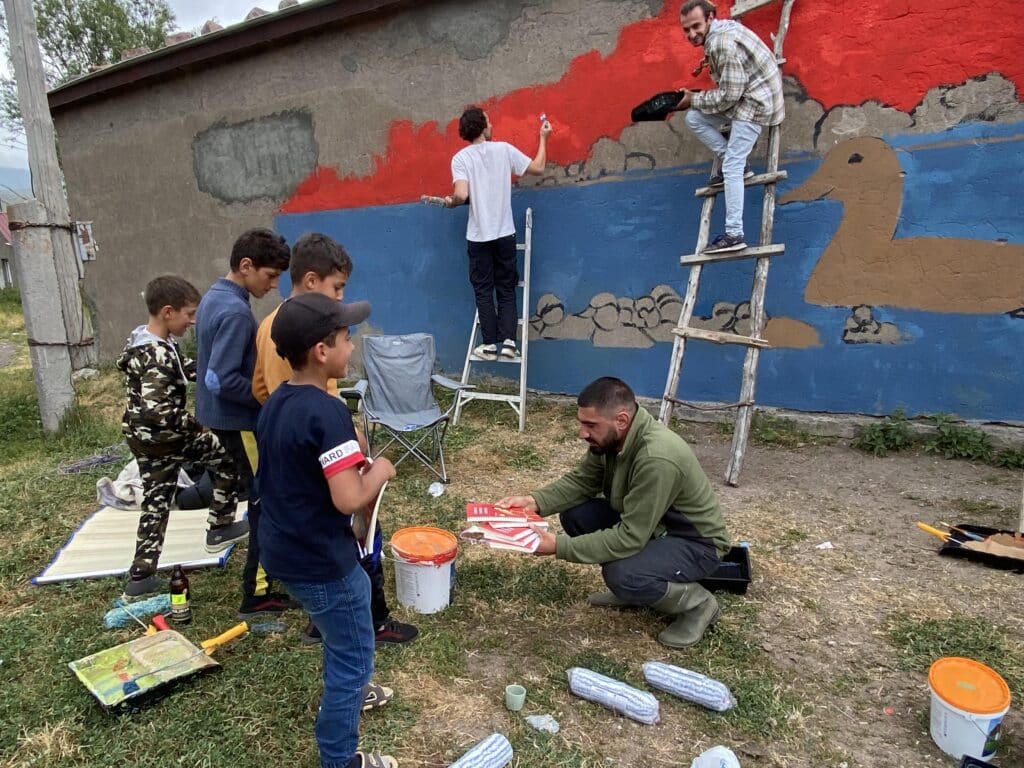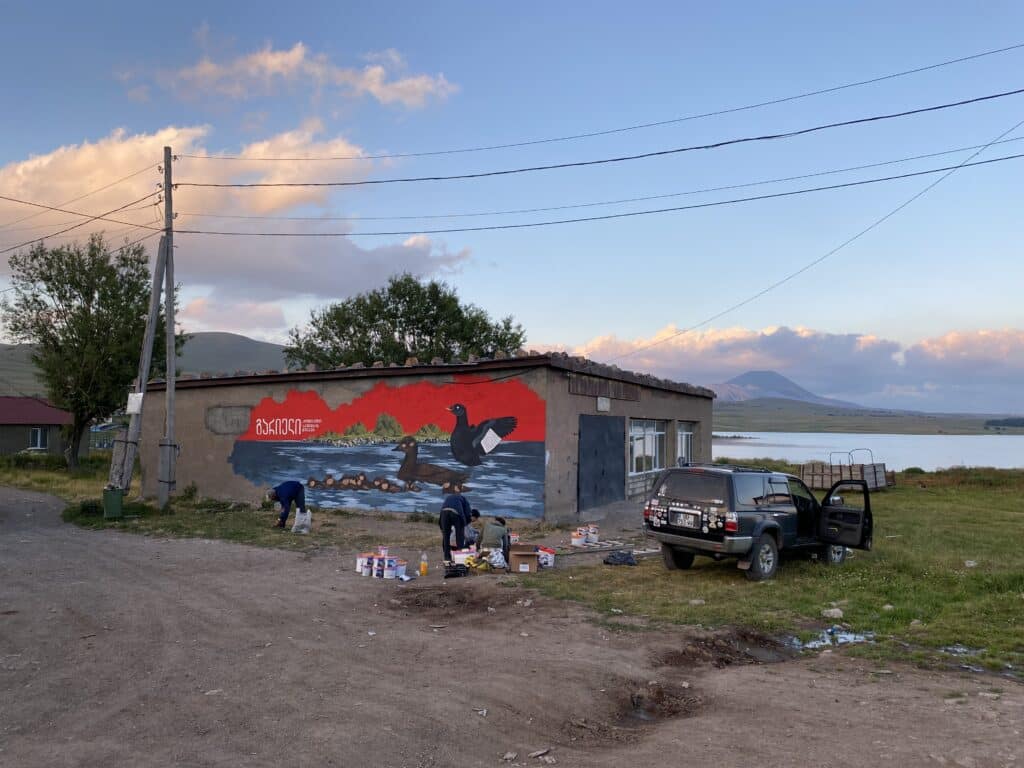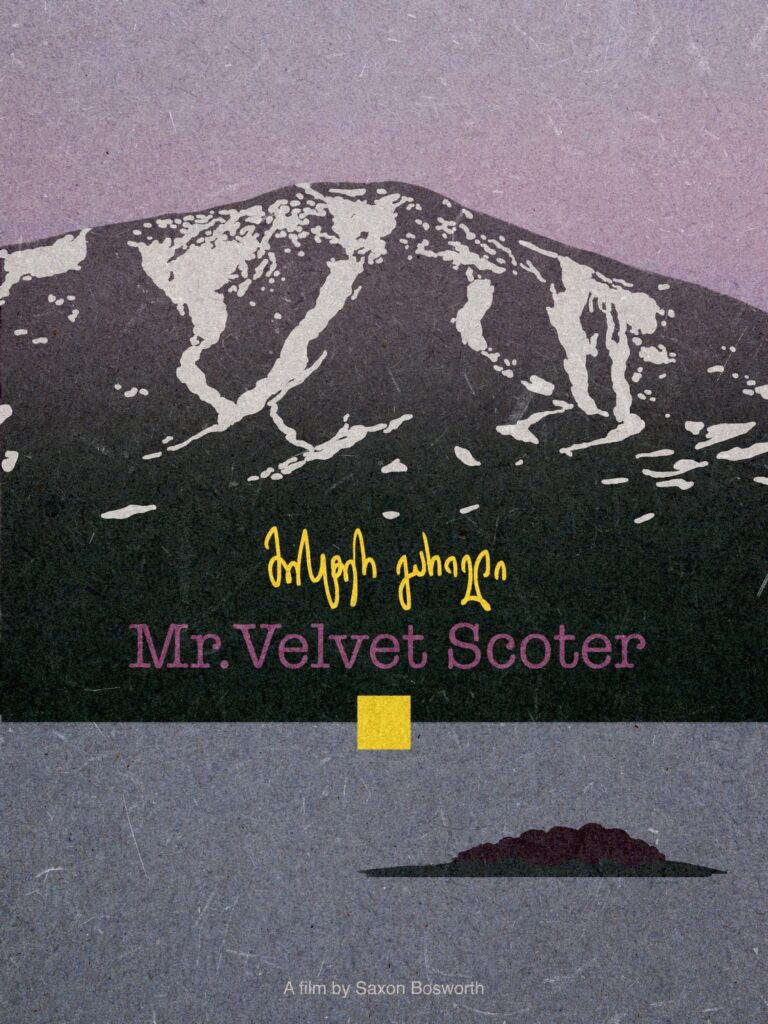This is the story of how we, Nature Conservation Georgia (NCG), ended up at the remote village of Tabatskuri, on Lake Tabatskuri – a serene landscape nestled in a volcanic plateau – where we painted gigantic Velvet Scoters. These are diving ducks, which were thought to be lost in Georgia and across the Caucasus until very recently when a miraculous discovery was made.

Velvet Scoter Mural. Photo by Luka Tkemaladze, NCG
The Velvet Scoter (Melanitta fusca), an arctic sea duck, was considered to be extinct in the Caucasus region until 2014, when it was rediscovered. The fact that we know there’s a breeding population of Velvet Scoter in Tabatskuri is thanks to Nika Paposhvili, who discovered Tabatskuri’s long-lost treasure. The discovery, as he recalls, was completely unexpected and unbelievable to those around him. After he found Velvet Scoters, he had to return a year later to confirm his observations, going to the island to catch a nesting female by hand. It then became his mission to save and protect the last population of Caucasian Velvet Scoters. Velvet Scoters are considered to be decreasing worldwide, and the state of the species is rated as vulnerable by the IUCN (International Union of Conservation of Nature). Now, Lake Tabatskuri in Georgia is their last breeding place in the Caucasus, which, we believe, needs more conservation attention and activities.

Velvet Scoter Nest. Photo by Saxon Bosworth
Thanks to the efforts by Nika Paposhvili, the number of breeding pairs has been increasing for the last few years. Nika is an ecologist and ornithologist who, since his work began, has successfully implemented several activities for this species, including scientific research, getting closer to the local community, and collaborating with other researchers or organizations to protect and save Velvet Scoter.
Last year, NCG happened to meet Nika when we were working on an awareness-raising project to update the Red List of Georgia. supported by GIZ. It was very important for the biodiversity of Georgia, with the Red List last being updated previously in 2014. During this project, several activities were implemented to share information about the updating process and its importance.
One of the activities was creating murals in different regions of Georgia to raise awareness about the “flagship” species that are specific to the chosen regions. While we were trying to find the spots for these murals, Nika suggested we visit Lake Tabatskuri and shared his work with us. We had the chance to visit the island where the Velvet Scoters are breeding and had one of the most memorable trips of our lives. We were so happy to collaborate with him and participate in the conservation of Velvet Scoter. And just like that, in a few weeks, we ended up in Tabatskuri, making a gigantic mural of Velvet Scoters with a view of Lake Tabatskuri itself.

Drawing the mural of Velvet Scoter and meeting with local residents. Photo by Luka Tkemaladze, NCG
During this period of time, Saxon Bosworth – filmmaker and researcher, and it may be said– nature enthusiast, was there filming Nika’s story and the conservation efforts surrounding the Velvet Scoter. He suggested that he would film some of the scenes of us drawing, and without any questions, we were happy to be a part of it. As you can imagine, we had such a great time – yes, working on a conservational activity can be a fun and interesting experience. In such a short time, we were able to do so much with this joy and excitement. Of course, scientific research is important, and nothing can be done without it, but we believe that if you don’t share it, it loses its purpose. That was one of the angles we were aiming for during the awareness-raising campaign and participation in Nika’s big project. The purpose of the murals is not just educational; it can change people’s mindset about things – in this case, the Velvet Scoters. They will have a story to tell to their friends or kids someday. While we were drawing, the locals used to gather around us and talk about it. What made this project extra special was the engagement, interest, and involvement of the local community, who cheered on our artwork throughout the process. It is a great conversation starter, and since we chose a location for the mural in the centre of the village, it is known to everyone who sets foot in the Tabatskuri.

Velvet Scoter mural with the view of Lake Tabatskuri. Photo by Luka Tkemaladze, NCG
Not to forget the movie we mentioned before, “Mr. Velvet Scoter” – after one year of untiring work, Saxon has finished the movie, and it is now available for everyone. The movie tells us the story of Nika and his strong connection with Velvet Scoter.

You’ll be able to hear about the discovery that we mentioned above in more detail. The story of Nika’s day-to-day life – the guardian of the last population of Velvet Scoter in the Caucasus. You’ll get to know Tabatskuri and its residents, including both friends and Velvet Scoters, as well as a thematic focus on the familial cost for conservationists, all partnered with the beauty of the mountainous plateau landscapes of Samtskhe-Javakheti.
About NCG: Nature Conservation Georgia (NCG) is a non-governmental organization working: to protect the Biodiversity of Georgia, raise awareness in local communities about environmental issues and its importance, and maintain, cherish and encourage harmony between us, humans, and nature.


